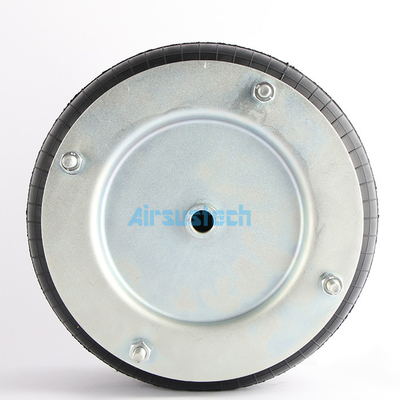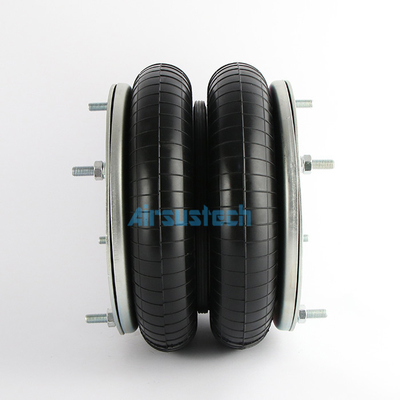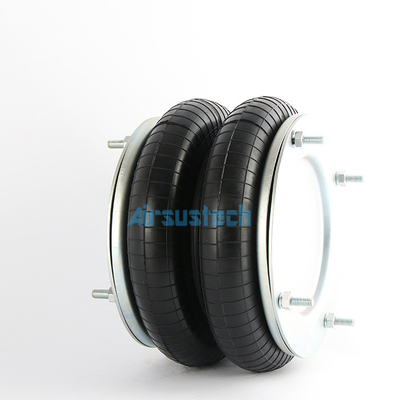16'' Diameter Double Convoluted Air Spring Pneumatic Bellows Actuators Contitech FD 816-30 DS Norgren M/31162
Product Details:
| Place of Origin: | Guangzhou China |
| Brand Name: | AIRSUSTECH |
| Certification: | ISO/TS16949:2009 |
| Model Number: | 2B16×2 |
Payment & Shipping Terms:
| Minimum Order Quantity: | 3Pieces |
|---|---|
| Packaging Details: | Strong Carton Box or as Customers Requirement |
| Delivery Time: | 5-8 Working Days |
| Payment Terms: | T/T, Western Union, Paypal or Others |
| Supply Ability: | 1000PCS/Week |
|
Detail Information |
|||
| Material: | Rubber + Steel | Certificate: | ISO/TS16949:2009 |
|---|---|---|---|
| Warranty Period: | One Year | Number Of Convolutions: | 2 |
| Packing: | Neutral Box Or As Customers' Request | Size: | 24×24×24 Cm |
| Type: | Convoluted Air Spring | Sample: | Available |
| Cross Reference: | Contitech FD 816-30 DS Norgren M/31162 | Pressure Ability: | 0.2-0.8 M PA |
| High Light: | 16'' Diameter Double Convoluted Air Spring,Contitech Double Convoluted Air Spring |
||
Product Description
16'' Diameter Pneumatic Bellows Actuators Contitech FD 816-30 DS Norgren M/31162 Double Convoluted Air Spring
Replace these air springs
AIRSUSTECH NO. 2B16X2
Contitech FD 816-30 DS
Contitech FD816-30 DS
Contitech FD816-30DS
Contitech FD 816-30 DS G 1/2
Contitech FD816-30DSG1/2
Contitech FD 816-30 1/2 M10
Contitech FD 816 30 1/2 M10
Contitech FD816-30 1/2 M10
Contitech FD816 30 1/2 M10
Also Known As: 68052
Norgren NO. M/31162
Norgren NO. M 31162
Norgren NO. M31162
Firestone W01 R58 4067
Firestone W01-R58-4067
Firestone W01R584067
Firestone WO1R584067
Firestone WO1 R58 4067
Firestone WO1-R58-4067
DUNLOP PNEURIDE 16''×2
DUNLOP SPRINGRIDE SP1557
PARKER 9109171
Specifications and Detailed Technical Parameters:AIRSUSTECH 2B12X2
|
Medium |
Compressed Air |
|
Operation |
Single acting |
|
Norminal diameter |
16'' |
|
Number of Convolutions |
2 |
|
Top/Bottom Cover Plate Screw (Nut) Tooth |
4PCS X M10Nut / Blind Nut |
|
Gas Hole / Air inlet/Portsize |
G1/2 |
|
Max. OD |
435mm |
|
DR |
460mm |
|
Top/Bottom Cover Plate Diameter (Width) |
310 mm |
| The screw center | 282.5mm |
|
Material top and bottom plate |
Steel |
|
Stroke of Rubber Bellows |
75 mm-390m |
|
Stroke length |
315mm |
|
Bumper block / Buffer block |
Without |
|
Girdle Hoop / Girdle Ring/Belt loop |
One Pieces of Girdle Hoop |
|
Rubber material Standard up to 70°C natural rubber |
|
Application
The rubber air spring as a shock absorbing base can effectively protect the high-precision machinery and equipment from being damaged during the transportation process, such as the transportation of cruise missiles and control launch systems. If the rubber air spring is used as a special tool for the support point, its light weight and convenient use can be used, which is conducive to the maintenance of suburban vehicles and machinery and equipment. Rubber air springs are also widely used in various mechanical equipment, vehicles and other industries.
The production of rubber shock absorbers needs to go through the following steps
1. Rubber refining
The preparation of rubber shock absorber compound is the same as that of ordinary rubber product compound. First, the raw rubber should be fully masticated to make it have suitable plasticity and uniformity. With the increase of mastication time, the rubber loss coefficient decreased and the dependence on the amplitude decreased. The key to kneading is to make the compounding agent disperse uniformly. If the rubber compound is mixed unevenly, the stiffness of the shock absorber will fluctuate, and the uneven hardness will cause stress concentration inside the rubber, thereby shortening the service life of the shock absorber.
2. Surface treatment and bonding of metal parts
Most rubber shock absorbers contain metal parts, and the surface of the metal parts must be treated before bonding with the rubber, otherwise the bonding strength will be affected. There are many surface treatment methods for metal parts, the most commonly used is sandblasting, then wash with solvent, and apply glue after drying. At present, the commonly used adhesive is chemlok, which has a very strong adhesive strength.
3. Vulcanization
The commonly used vulcanization methods of rubber shock absorbers are molding vulcanization, mold transfer vulcanization and injection vulcanization. Note: The vulcanization time and temperature should be strictly controlled during vulcanization. Generally speaking, the degree of crosslinking of rubber increases with time, the modulus of rubber increases, and the consumption coefficient of rubber decreases. Therefore, the vulcanization of the rubber shock absorber should be sufficient. If the under-sulfur and over-sulfur are all, the performance of the finished product will be reduced.
The related picture of 2B16×2 pneumatic bellows actuators
![]()







